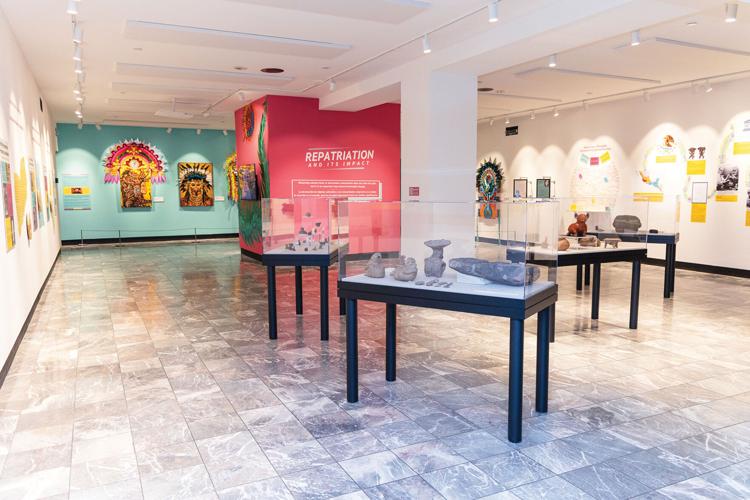In the late 1960s, Oregon doctor John L. Montgomery began corresponding with Malcolm Parker, who was then the director of Nashville’s Parthenon. As part of the current exhibition Repatriation and Its Impact, on the Parthenon’s gallery wall now hangs a 1968 photograph of Parker proudly holding an artifact that was, at the time, on loan from Montgomery. Next to the photograph is a handwritten letter from 1970, which is enlarged and affixed to the museum wall like a plaque. In the letter, Montgomery announces his donation of works to the Parthenon, details their appraised value and adds a postscript that he intends to make similar donations annually.
What the letters leave out is how Montgomery got the works in the first place. But after hearing about the exhibition in a recent episode of NPR’s All Things Considered, Montgomery’s son Rich made a call to the Parthenon’s assistant curator Bonnie Seymour with those details.
“He gave me the whole rundown,” Seymour says of her conversation with Rich Montgomery as she stands in front of one of the exhibition’s display vitrines. “It’s similar but different — very different — than what we thought originally. It turns out that he would have never done it by himself. He sent his sons, Rich and his brother, down to western Mexico, they got a car —”
“— tricked out with a false bottom,” Parthenon director Lauren Bufferd interjects.
“Right, and that’s where they stored their gear,” Seymour continues. “That’s also where they stored the stuff that they got.” Seymour and Bufferd are clearly pleased to have the additional provenance for their items. It doesn’t hurt that these details sound like a flashback montage in a heist film.
Two-hundred-forty-eight items in the Parthenon’s collection came from the relationship between Montgomery and Parker, and 61 of them are currently on display. But what the Parthenon’s current exhibition is actually about is not the artifacts themselves, but rather the concept of repatriation.

Returning an object to its country of origin is hardly a new idea, but in recent years it has become more and more urgent. The British Museum — which, due to the British Museum Act of 1963, is prohibited from returning artifacts — is grappling with it. In a meeting with Pope Francis on June 14, Canadian Prime Minister Justin Trudeau urged the pope to follow through on promises to return Indigenous artifacts from the Vatican to Canada. Just last year, the American Museum of Natural History began to review its repatriation process while removing human remains from public display.
“We have strong allies in other countries in this endeavor to recover pieces that have been taken away from their territory,” Javier Díaz de León, the consul general of Mexico in Atlanta, tells the Scene by phone from his office. “One of the largest efforts that we, Italy, Egypt of course, have done is to try to create a greater awareness of this issue.”
According to Montgomery’s son, he and his brother took several trips to Mexico to collect artifacts, and people would line up to bring them things — farmers who found items while tilling their fields, or people who had collected things while wandering the forests. The artifacts include arrowheads, mostly, but also ceremonial drinking vessels, ceramic pots, ocarinas shaped like tiny songbirds. They sold them for cheap.
“And they would pack up the Suburban with them, drive over the border, give it all to his dad, and his dad would have them appraised,” Seymour says, using air quotes when she says “appraised.” After that, Montgomery often sold them to friends, and those friends would donate the items to museums — “to get a tax break” Bufferd explains, acknowledging that there are almost certainly other museums whose collections were amassed through the same source.
All this adds a sensational element to the bilingual exhibition, which is multifaceted and includes extensive wall texts and contemporary work from Nashville-based artist José Véra González. The exhibition benefits from González’s inclusion for several reasons. He was originally from the same area of western Mexico as the artifacts — something Seymour says is a happy coincidence. But González is also a skilled muralist, and his painted dragon serves as the exhibition’s timeline. Running behind the photographs of Montgomery’s letter and Parker’s proud face, González’s fantastical dragon-serpent is a constant presence in the background. The takeaway is clear — this isn’t all ancient history. Relationships are still being formed, and they will continue.
Before the items are returned to Mexico, five of them will be scanned with 3D printing technology by local company Pr3nter. One of the biggest challenges, says Seymour, is choosing which of the 248 items will be scanned.
“If I had my way, we’d 3D-print them all,” she says. “But these will be the ones that we think would best help reflect our mission, and help us keep a piece of the spirit of the collection in Nashville.”

“Even though the collection is leaving here, it has to do with our history, the history of the museum,” says Bufferd. “The story of how they passed through — and why — and why we’re eager to have them be in a more appropriate institution.”
When the exhibition ends in July, the artifacts will be returned to Mexico.
“There is an elaborate procedure that we have constructed,” de León explains. “The materials are very fragile, so a lot of special care needs to be taken. Through the diplomatic connection with the headquarters in Mexico, they will be put in Instituto Nacional de Antropología e Historia — the Institute of Anthropology and History — in Mexico City.
“So far, several exhibitions of recovered materials have already happened in Mexico,” he continues. “I would expect that, hopefully sometime in the future, some of these pieces will be exhibited in Mexico.”
“We wish everybody was like The Parthenon,” de León adds. “They’re setting a great example, and maybe other museums should follow.”






